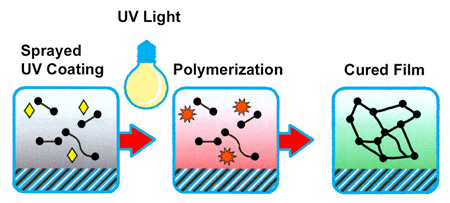Auto Technical Reference Library |
Topic
Index |
UV (Ultraviolet) cured sealers, primer surfacers and spot fillers are already making in-roads in the refinish market. Additional UV cured products, including clear coats and body fillers are in development and expected to debut shortly. While UV paint systems are still somewhat new in the collision repair industry, the basic technology has been in use in various industrial applications for some time. UV technology is also used in several OEMs applications.
Types of UV paint systems include UVA, a low-energy system used by repair facilities and UVC, a high-energy system utilized by OEMs.
Technology
UV paint is cured by a process called polymerization (cross-linking of molecules) rather than heat-induced evaporation. Polymerization is put into motion by a chemical photo-initiator in the paint mix, which acts as a catalyst as it absorbs and reacts to UV light. It’s the cross-linking of molecules, started by exposure to UV light that produces a hard-cured paint film.

While the UV rays found in natural sunlight are sufficient to begin the curing process, most paint manufacturers recommend using a lighting fixture with a specialized lamp that produces light energy in a very specific range or wavelength. Typically, the fixture is placed four to twelve inches away from the coated part surface and turned on. Once the paint is fully cured, usually in two to five minutes, the lighting fixture is removed. Once cured, the surface can be sanded just like a conventional solvent-based coating.
Benefits
UV cured coatings produce extremely durable finishes that are scratch, chemical and mar resistant. Tests have shown the UV cured clear coats show significantly less surface degradation over time than urethanes.
UV coatings are also:
![]() Faster, with dramatically reduced cure times. Cure times very from approximately two minutes to near instantaneous.
Faster, with dramatically reduced cure times. Cure times very from approximately two minutes to near instantaneous.
![]() More energy-efficient than thermal (heat) curing. With UV-cured paints, there is no need to heat a paint oven, prep-station or use infrared (IR) lamps. While UV lighting fixtures do produce some heat, it is not a factor in the curing process.
More energy-efficient than thermal (heat) curing. With UV-cured paints, there is no need to heat a paint oven, prep-station or use infrared (IR) lamps. While UV lighting fixtures do produce some heat, it is not a factor in the curing process.
![]() Safer to use. UV paints produce fewer if any VOC emissions, since there is no evaporation of solvents as occurs with conventional coatings. Also, UV paints to do not contain isocyanate catalysts or epoxy activators.
Safer to use. UV paints produce fewer if any VOC emissions, since there is no evaporation of solvents as occurs with conventional coatings. Also, UV paints to do not contain isocyanate catalysts or epoxy activators.
![]() Less prone to typical paint defects. UV coatings are particularly effective as a sealer on porous surfaces such as SMC and plastic molded parts where lifting or “popping” of the finish can occur due to “out-gassing” of solvents absorbed by the part during conventional refinish operations.
Less prone to typical paint defects. UV coatings are particularly effective as a sealer on porous surfaces such as SMC and plastic molded parts where lifting or “popping” of the finish can occur due to “out-gassing” of solvents absorbed by the part during conventional refinish operations.
![]() Less wasteful. UV-cured primers currently on the market are ready-to-spray, so there aren’t mixing or pot-life issues.
Less wasteful. UV-cured primers currently on the market are ready-to-spray, so there aren’t mixing or pot-life issues.
Repair Issues
In general, UV-cured coatings are compatible with conventional refinishing systems. UV primers (comprised primarily of urethane resins, although acrylics, epoxies and polyesters are also used) can be applied over all automotive substrates and are compatible with all topcoats offered by the same paint manufacturer.
UV cured coatings can be used for spot repair with sanding to ensure proper adhesion. In most cases, adhesion can be maximized by wet-on-wet applications or “B-stage” curing where low level UV light is used to set the first coat, followed by a full cure on subsequent coats.
Challenges
At present, UV-cured clear coat technology is still being perfected. The major stumbling block — automotive clear coats are designed with additives to block UV rays to prevent delaminating and fading of the base coat. Unfortunately these additives can also prevent the clear coat from curing properly.
Also, UV cured basecoats are not available, since the opaque nature of the color coat prevents UV light from penetrating it. The primers currently on the market are semi-translucent, allowing UV light to penetrate the coating and begin the curing process.
Finally, there is some difficulty in achieving a full-cure in painted areas not directly exposed to UV light, e.g., in shadow areas. Obviously, this reality can be somewhat problematic when refinishing large, three-dimensional objects like cars and trucks. This challenge is being addressed with moving UV lights or multiple lamp set-ups.